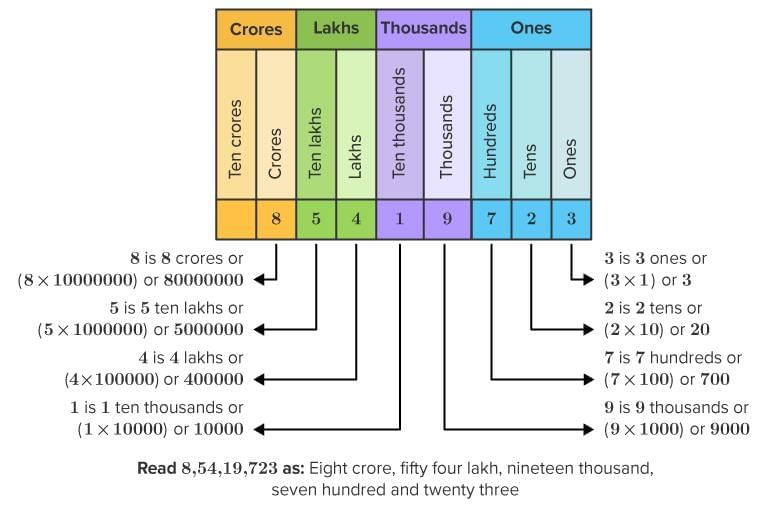Olympiad Notes: Number Sense (7and 8 Digit Numbers) | Math Olympiad for Class 5 PDF Download
| Table of contents |

|
| Introduction |

|
| Place Value System |

|
| Face Value and Place Value |

|
| Successor and Predecessor |

|
| Comparing Large Numbers |

|
| Writing Numbers in Words |

|
| Conversions |

|
Introduction
Numbers can be very large. A 7-digit number is the number that has 7 digits. The smallest 7-digit number is 10,00,000 (ten lakh) and the largest is 99,99,999. An 8-digit number is the number that has 8 digits. The smallest 8-digit number is 1,00,00,000 (one crore) and the largest is 9,99,99,999.
Place Value System
The value of a digit depends on its position.
In the Indian Place Value System, we use commas like this: 1,23,45,678. The first comma comes after 3 digits from the right, and then commas are placed after every 2 digits. The order of places is: Ones, Tens, Hundreds, Thousands, Ten Thousands, Lakhs, Ten Lakhs, Crores.
Example: In 7,23,45,678
- 7 = Crore → 7,00,00,000
- 2 = Ten Lakh → 20,00,000
- 3 = Lakh → 3,00,000
- 4 = Ten Thousand → 40,000
- 5 = Thousand → 5,000
- 6 = Hundred → 600
- 7 = Ten → 70
- 8 = One → 8

Expanded form: 7,00,00,000 + 20,00,000 + 3,00,000 + 40,000 + 5,000 + 600 + 70 + 8
In the International Place Value System, commas are placed after every 3 digits from the right. For example: 72,345,678. The order of places is: Ones, Tens, Hundreds, Thousands, Ten Thousands, Hundred Thousands, Millions, Ten Millions.
Example: In 72,345,678
- 7 = Ten Million → 70,000,000
- 2 = Million → 2,000,000
- 3 = Hundred Thousand → 300,000
- 4 = Ten Thousand → 40,000
- 5 = Thousand → 5,000
- 6 = Hundred → 600
- 7 = Ten → 70
- 8 = One → 8
Expanded form: 70,000,000 + 2,000,000 + 300,000 + 40,000 + 5,000 + 600 + 70 + 8
Face Value and Place Value
The face value of a digit is the digit itself. The place value of a digit is the digit × its place.
Example: In 6,58,32,719
- Face value of 8 = 8
- Place value of 8 = 8,00,000 (since it is in the lakh place)
Successor and Predecessor
- The successor of a number is the number that comes just after it (add 1).
- The predecessor of a number is the number that comes just before it (subtract 1).
Examples:
- Successor of 54,32,100 = 54,32,101
- Predecessor of 70,00,000 = 69,99,999
Comparing Large Numbers
To compare numbers, start from the leftmost digit (highest place).
Example: Compare 6,45,23,178 and 6,54,23,178
- Both have 6 in the crore place → equal
- Compare next digit: 4 (ten lakh) and 5 (ten lakh) → 5 is bigger
So, 6,54,23,178 is greater.
Writing Numbers in Words
Numbers are read differently in Indian and International systems.
Examples:
- Indian: 4,56,78,901 → Four crore fifty-six lakh seventy-eight thousand nine hundred one
- International: 45,678,901 → Forty-five million six hundred seventy-eight thousand nine hundred one
Conversions
- 1 Lakh = 1,00,000
- 10 Lakhs = 10,00,000 = 1 Million
- 1 Crore = 1,00,00,000 = 10 Million
- 10 Crores = 10,00,00,000 = 100 Million = 1 Billion
|
37 videos|109 docs|51 tests
|
FAQs on Olympiad Notes: Number Sense (7and 8 Digit Numbers) - Math Olympiad for Class 5
| 1. What is the difference between face value and place value in a number? |  |
| 2. How can I find the successor and predecessor of a given number? |  |
| 3. What methods can be used to compare large numbers? |  |
| 4. How do I write large numbers in words correctly? |  |
| 5. What are the steps to convert numbers between different forms, such as standard form and expanded form? |  |














